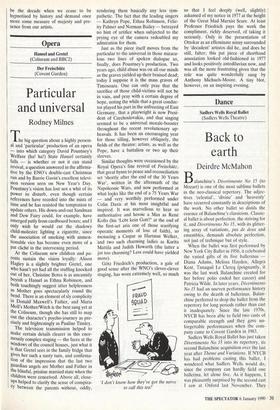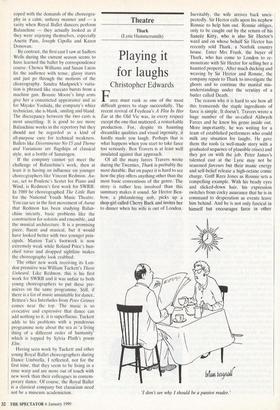Dance
Sadlers Wells Royal Ballet (Sadlers Wells Theatre)
Back to earth
Deirdre McMahon
alanchine's Divertimento No 15 (to Mozart) is one of the most sublime ballets in the neo-classical repertory. The adjec- tives :celestial', 'divine' and 'heavenly' have recurred constantly in descriptions of the work. No other ballet so distils the essence of Balanchine's classicism. Classic- al ballet is about perfection, the striving for it, and Divertimento No 15, with its glitter- ing array of variations, pas de deux and ensembles, demands absolute perfection, not just of technique but of style.
When the ballet was first performed by New York City Ballet in 1956, it celebrated the varied gifts of its five ballerinas — Diana Adams, Melissa Hayden, Allegra Kent, Tanaquil Le Clercq (poignantly, it was the last work Balanchine created for her before polio ended her career) and Patricia Wilde. In later years, Divertimento No 15 had an uneven performance history owing to the dearth of ballerinas. Balan- chine perferred to drop the ballet from the repertory for long periods rather than cast it inadequately. Since the late 1970s, NYCB has been able to field two casts of comparable strength and they gave un- forgettable perforMances when the com- pany came to Covent Garden in 1983. Sadlers Wells Royal Ballet has just taken Divertimento No 15 into its repertory, its second Balanchine acquisition over the last year after Theme and Variations. If NYCB has had problems casting this ballet, I wondered what Sadlers Wells would do, since the company can hardly field one ballerina, let alone five. As it happens, I was pleasantly surprised by the second cast I saw at Oxford last November. They
coped with the demands of the choreogra- phy in a calm, unfussy manner and — a rarity when Royal Ballet dancers perform Balanchine — they actually looked as if they were enjoying themselves, especially Anette Pain, Joseph Cipolla and Karen Donovan.
By contrast, the first cast I saw at Sadlers Wells during the current season seems to have learned the ballet by correspondence course. Chenca Williams and Susan Lucas fix the audience with tense, glassy stares and just go through the motions of the choreography. Sandra Madgwick's varia- tion is phrased like staccato bursts from a machine gun. Bonnie Moore's limp arms give her a constricted appearance and as for Miyako Yoshida, the company's whizz technician, she is blank, smiling and bland. The discrepancy between the two casts is most unsettling. It is good to see more Balanchine works in the repertory but they should not be regarded as a kind of all-purpose cure for technical weakness. Ballets like Divertimento No 15 and Theme and Variations are flagships of classical style, not a bottle of Sanatogen.
If the company cannot yet meet the challenge of Balanchine's work, then at least it is having an influence on younger choreographers like Vincent Redmon. Au- ras, set to Poulenc's Sextet for Piano and Wind, is Redmon's first work for SWRB. In 1989 he choreographed The Little Rats for the National Youth Music Theatre. You can see in the first movement of Auras that Redmon has been studying Balan- chine intently, basic problems like the construction for soloists and ensemble, and the musical architecture. It is a promising piece, fluent and musical, but it would have looked better with two younger prin- cipals. Marion Tait's footwork is now extremely weak while Roland Price's hun- ched torso and dropped sightline makes the choreography look crabbed.
The other new work receiving its Lon- don premiere was William Tuckett's Those Unheard. Like Redmon, this is his first work for SWRB and it was unfair to both young choreographers to put these pre- mieres on the same programme. Still, if there is a list of music unsuitable for dance, Britten's Sea Interludes from Peter Grimes comes near the top. The music is so evocative and expressive that dance can add nothing to it, it is superfluous. Tuckett adds to his problems with a ponderous programme note about the sea as 'a living thing of a different order of humanity' which is topped by Sylvia Plath's poem Elm.
Having seen work by Tuckett and other young Royal Ballet choreographers during Dance Umbrella, I reflected, not for the first time, that they seem to be living in a time warp and are more out of touch with new work than their colleagues in contem- porary dance. Of course, the Royal Ballet is a classical company but classicism need not he a museum academicism.











































 Previous page
Previous page